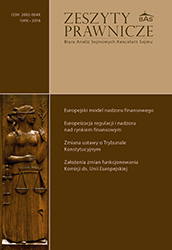Europejski model nadzoru finansowego – kierunki rozwoju
The European model of financial supervision. Main developments
Author(s): Włodzimierz SzpringerSubject(s): Economy, Law, Constitution, Jurisprudence, National Economy, Supranational / Global Economy, Law on Economics
Published by: Kancelaria Sejmu
Keywords: European Banking Union; European Central Bank; single supervisory mechanism; single resolution mechanism; european stability mechanism; Meroni, Romano and Pringle doctrine
Summary/Abstract: The complexity and uncertainty in the application of the European system of financial supervision is due to the fact that its particular concepts were implemented at different times. First, it was the system of European financial supervisors (EBA, EIOPA, ESMA), which was primarily aimed at coordination of national activities. Then, the European Banking Union was established, comprised of the Single Supervisory Mechanism (SSM), and the Single Resolution Mechanism (SRM), as well as the European Stability Mechanism (ESM) which must also be seen in the context of assistance to troubled banks. Difficulties of interpretation are further compounded by a lack of consistency in approach to the institutions subject to examination. Should they include only the euro zone, or the whole EU, only the banks or other institutions as well? If you take into account the SSM, SRM or ESM, it is often not very clear who and when should act what tools should be applied, For example, when the ECB may, and should, correct decisions of national supervisors and what, in the context of increasing involvement of the ECB in the banking union, is the role of the ESRB; whether and when banks can possibly challenge decisions eg. on establishing a capital buffer or inclusion on the SIFI list, etc. Also unclear is the role of the EBA and ESMA in the context of the creation of a banking union, SSM, SRM and ESM and delegation of regulatory powers of ECB and the Commission to regulatory agencies (Meroni doctrine) or creation of regulatory agencies beyond the Treaty (Pringle doctrine).
Journal: Zeszyty Prawnicze BAS
- Issue Year: 2016
- Issue No: 49
- Page Range: 9-43
- Page Count: 35
- Language: Polish

